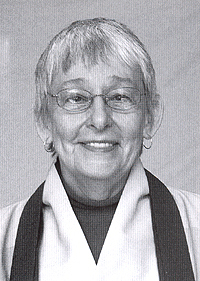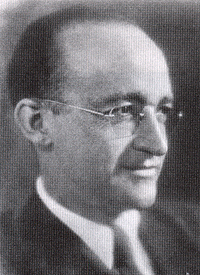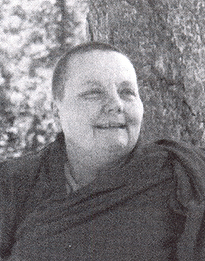By Margaret McKenzie
Originally printed in the SEPTEMBER-OCTOBER 2006 issue of Quest magazine.
Citation: McKenzie, Margaret."Everyday Enlightenment." Quest 94.5 (SEPTEMBER-OCTOBER 2006):171-173, 196.

When I first heard of the idea of enlightenment, I thought it was some mysterious unusual state; something like levitating or being out of the body, and available only to a select few. In studying and practicing Zen, I have come to see that enlightenment means something else.
When the Buddha sat under the tree and saw the first star in the early morning, he did not see anything extraordinary. He saw the star complete as it was and observed:"How remarkable; everything already has it." We are all already enlightened, but we fail to see it, because we are caught in desire.
The second noble truth says that it is my attachment, or desire, to having things be a particular way that causes my suffering, not the events themselves. It is my identification with my opinions, my ideas, my likes and dislikes that are the cause of my misery. Sitting one hundred days in the woods provided me with an opportunity to watch events unfold very completely; to let me see things simply as they are—not as I want them to be.
In the fall of 2004, I spent one hundred days in a hermitage in northern Wisconsin and did a silent Zen retreat. The external frame of my days was structured with each day just the same as the day before. I did a three-hour block of bowing, chanting, sitting, walking, and a physical practice like yoga. I repeated this block four times a day. In between practices I cooked, ate, cleaned, and slept.
I brought four books with me. I read from one of them each morning, another each night. I took a walk everyday; the same walk of about a mile and a half down to the main road and back again. Everyday I ate the same meals of oatmeal, rice, carrots, squash, dried fruit, protein powder, and peanut butter. By removing so very many of the choices that enchanted, bewildered, perplexed, and confused me on a daily basis, I gradually cleared away the clutter and opened a welcoming place in my heart. It was a space where everything in the world, outside and inside, could receive my full attention.
Narrowing the field of one's attention and then dwelling within that space through the turning of two seasons, permits the very smallest aspects of the place to be revealed. All that surrounded me were a few acres, two ponds, a few buildings, the woods, a meadow, and a road. This allowed me to dwell in the landscape, perceive impermanence, the shifting of the seasons, the variety in the day, and to observe all of this with all of my senses.
I arrived in the last week in August. It was still hot, with the temperature in the eighties. The trees were green and full. In contrast, I was overweight and out of shape. I sweated until my clothes were soaked and my body throbbed. At night I fell into bed like someone who had been mining coal all day. I have never in my life slept with the deep unconsciousness that I did in those first few weeks. However, in the months between my arrival August and my departure in December, my habitual mind began to wear away and by the time I left, I felt empty within my clothes and rarely slept past three in the morning.
The routine of practice gradually sharpened my attention, allowing awareness of my environment to become more and more acute. I seemed to understand the way that my senses had been developed to let me live within a landscape. I named parts of the road where I walked by events that occurred there: the stream where I saw the muskrat, the tree where the pileated woodpecker sat, the patch of milkweed that changed from green to bright gold in a single night.
In October, as the leaves changed, I was able to identify the leaves that were different from the day before. In my daily rounds, I encountered new companions: the two cats that periodically accompanied me on my walks; the cows I heard every morning from a mile away, but never saw; the coyotes that howled in the middle of the night, and the deer.
There were about fifteen deer living on the land. When I arrived in August, there were several family groups; fawns with spotted pale patches on their coats, half the size of the adults, standing near their mothers. Besides the fawns and mothers, a third group looked to be gangly yearlings. The deer were around my cabin everyday. In the very early morning I would encounter them, strewn throughout the woods in groups of five or six.
At first I would know they were there because my heavy footsteps would spook them and they appeared to me as flipped tails and feet, racing off through the woods. As time went by though, we tamed each other. In learning to be more aware of my walk, I skillfully and quietly became a regular part of their landscape. By the end of September, I regularly walked within a few feet of them as they grazed around the land. They would lift their heads, gaze at me with their beautiful almond eyes, and go back to eating.
I began to talk to them, calling them the"dear deer" and"little friends." Since I was keeping such a regular schedule, the shifting of the season was apparent by my morning encounters with them. They entered the property on the east end and browsed their way through, exiting into the woods to the west. As the days shortened, I encountered them at different points in the landscape.
The deer appeared in the evenings as well. My hermitage was across from a small pond. Often, just at sundown, they would materialize out of the woods, drinking from the pond, making their way across the meadow into the space around the hermitage. Sometimes they came so close I could hear them eating.
All through October, I dwelt in a golden, sunlit land, pillared about with maple, oak, and aspen trees. I settled in, with my body settling, my mind slowing, and my heart opening. A crop of golden mushrooms appeared in the front of the cabin. Every evening three teenaged deer would come and eat them. They loved them so much that I could pass right by them into my cabin and they would stay still, mushroom crumbs falling from their mouths.
One day, as I sat to eat my lunch, I looked out the back window and noticed two deer that were sleeping. Curled up a few feet apart, each kept one funnel shaped ear erect, turning it constantly, scanning the land for change. I learned so much about attention from that half hour of watching them. They knew exactly how much attention to pay, when to stir, when to lift a head and look, and when to think about moving on. When they got up, they stood close together and groomed each other like cats.
Golden days do not last forever, though. The weather turned, and the leaves began to fall; slowly at first, and then it seemed all at once the trees were bare. The sky turned gray and the first of a month of rainy days arrived.
Life shifted in the deer herd, too. The groups were smaller, the teenagers sprouted antlers almost overnight. The herd seemed restlessness and jumpy. Males with full racks of antlers often came crashing through the woods. The days grew shorter and I came upon the deer less and less often while walking.
Then one day in early November, I was taking my walk to the main road when two men in a truck stopped me. They wanted to know who owned the woods and if the land was posted. I said I did not know and kept walking. When I looked for signs, I saw only one side of the road was posted"no hunting," while the other was not.
The next day I got a message from the woman who managed the hermitage saying that it was hunting season. She sent me some orange clothing with instructions to wear it whenever I walked off the property. Hunting season opened with bow hunting. It would continue for one month with firearms allowed during the last two weeks.
The first moment I fully absorbed the news about the hunting season, my mind began to go a hundred miles an hour. My mind became a trapped animal as I considered options: I would leave; or I would go into the woods and make a lot of noise; or I would confront the hunters and try to reason with them. A million ideas arose, but I actually did nothing except what I had been doing for the last sixty-five days: bowing, chanting, sitting, walking, and eating.
All that day I practiced, while crying and thinking,"I have to leave. No one would expect me to stay here while my beloved deer are being killed. I will call my teacher, she will understand. I have done my best. I must go."
For much of my life, I have been a leaver. When I had unpleasant neighbors, I moved out. When I had a difficult boss, I got a different job. When my marriage ran into rough waters, I departed. It became a style of mine: When problems appeared, I departed.
One of the first lessons of Zen meditation is about staying put. At a retreat during a sitting period, you do not just get up and leave. When you show up for a weekend retreat, you are expected to stay the whole time. During my years of practice, I learned something about staying. Whether sitting with uncomfortable physical sensations, sitting with unpleasant memories, different agitations, grudges, or itches, the practice is to just stay put and watch the parade come and go. Now, even though I felt like leaving, I knew I would not do so. I thought, planned, raged, but I did not go anywhere. I just kept on bowing, sitting, chanting, eating, walking, and sleeping. Things shifted.
First, I decided that what I could do was chant. There is a chant with the purpose of sending energy and healing. I started to do that chant for the deer on my walk each day. The second day, I decided to chant for the hunters, too. The weeks of bow and arrow season passed. I saw few hunters, encountered no killed deer. Then it was the opening day for gun season.
I was sitting on my cushion when dawn—or whatever the signal to begin hunting season was—arrived. The air filled with gunshots and it did not stop for two hours.
I sat on the cushion, got up, made my breakfast, and had a cup of tea. In all that time, the guns never stopped and I did not stop crying. Again, the same flood of thoughts broke over me:"I will call my teacher; I must get out of here; no one would blame me for leaving early."
And then a different thought appeared:"This is what a war is like." All over the world, there are people who live with this every day—except they are not safely tucked away in a hermitage with a choice about staying or going. The guns are outside their windows, in their houses. It is not deer that are getting killed; it is their families, friends, and neighbors. I had a rush of understanding about the privilege of my whole life: How blessed I had been to have never been in a war and how incredibly fortunate I was to be on this retreat.
I remembered a practice called tonglen. In it, you breathe in the suffering you are experiencing on behalf of everyone who is suffering and when you breath out, you send them peace and calm. It was easy and also a great relief to breathe in the suffering of all who hear gunshots and grieve, and to send them the peace I had known in the golden light of October.
Over the last weeks of hunting season, things gradually began to shift around inside of me. I did not leave. After that first day, I never thought about leaving again. I did my practice everyday and tried to bring the practice and the situation of sitting in the midst of shooting, together. I kept asking,"What is this?" Different answers appeared out of my practice. I sat at times full of compassion for all those who sit in the midst of shooting: people in Iraq, in Palestine, and the people who live in cities where there are gangs. I thought of my own"shooting," judging, condemning, and writing off different people, and I sent loving kindness and compassion to those memories and the places in my mind from where they arose.
I continued to encounter hunters when I walked at noon. I worked at keeping my heart open to them, acknowledged that I did not know what hunting meant to them, and sent them loving kindness when I walked by them. I fell into the rhythm of hunting— hearing the shooting at dawn and dusk, while noticing the quieter moments in between.
One day, toward the end of the two-week season, I got up from my cushion and walked to the window. It was sundown, but there was still a lot of shooting going on down the hill. I looked out the window; there were six deer out at the pond. They were drinking and grazing, and began walking uphill toward my cabin.
Bang, bang!—there went the guns—quite loud. The deer did not do anything. They did not lift their heads or even look toward from where the sound was coming. They did not have a conversation with each other about how awful the shooting was. They ate and drank and walked up the hill.
I started laughing just then and woke up to something: I saw the truth about the suffering of those two weeks. I recognized how my suffering arose from my ideas about how my retreat should be, about the lives of deer, about the character of the hunters, and not from the facts of the deer.
The deer just lived their lives, eating, drinking, walking, and when they were shot, dying. They did not spend any time beforehand thinking about dying. The cause of suffering was not the event itself, but my attachment to having the world run a particular way.
The hunting season ended, much as it began, with a two-hour barrage of shooting at the end of the day. Then quiet returned and continued through the last week of the retreat. One morning I went out to walk before breakfast. The sun was just coming up. I walked up to the big meadow. The sun was just rising and all the clouds were streaming from behind me toward the rising sun. The clouds all looked like rows of tiny square pillows; the wind was behind them and they were racing toward the sun. I had this complete sense of the world turning quickly toward the sun. I stood transfixed.
As the clouds moved and the sun rose, different parts of the clouds became illuminated in pink, rose, peach, coral, gold, and yellow as though someone was turning lights off and on, illuminating first one pillow and then another. I must have stood for ten minutes, unable to move.
Suddenly a door slammed. Hearing a rustle behind me, I turned to see a whole herd of deer barely ten feet from me. They turned, flipped up their wonderful white tails and were gone. Following their spontaneous retreat, I watched intently as they sped away, moving smoothly, effortlessly across the meadow and through the filigree of clean, bare, open woods beyond.
Margaret McKenzie is a social worker in Du Page County, Illinois. She is a Senior Dharma Teacher in the Kwan Um School of Zen where she has been a student of Zen Master Barbara Rhodes for thirteen years. Margaret has been a member of the Theosophical Society since 1995.





